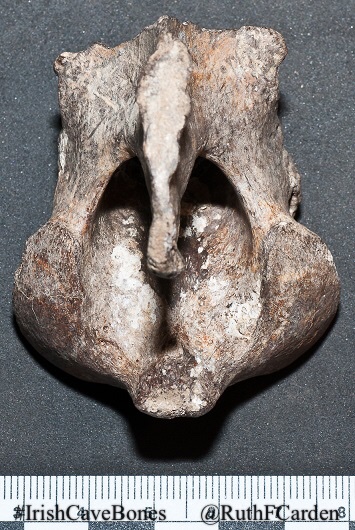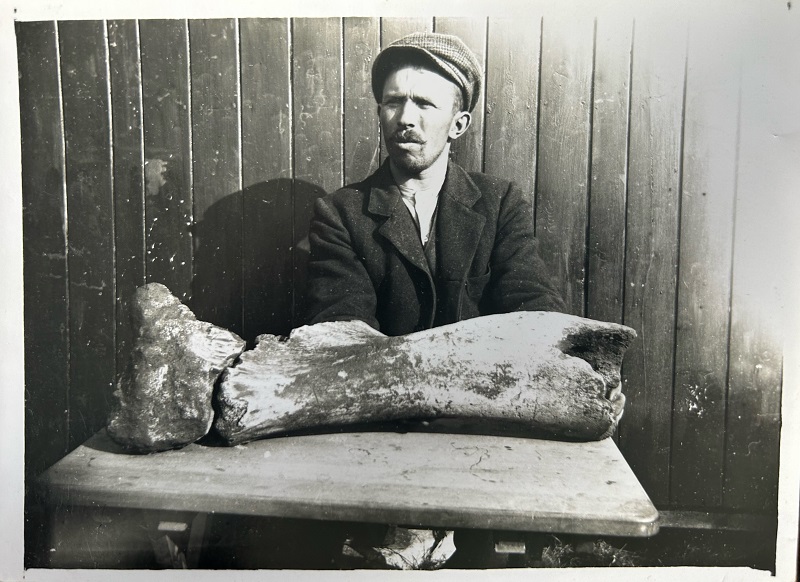#IrishCaveBones Day5: 1/n So let's continue on our time travelling & jump forward in time to c.14,000 years BP & then continue from there. We do have a gap of knowledge between c.17,000 to c.14,000 years simply due to lack funding for radiocarbon dating of bones & other analysis.
2/n @RuthFCarden here again, tonight I have a mug of mint tea to join me on this thread. We do hope to get some of that time gap addressed, if we can, between now & end @IrishResearch grant Sept. '24. Tonight let's focus on what happened and a particular human-animal relationship
3/n Ireland's landscape was a nice place of many kinds of animals, those that stayed/recolonised after the last Ice Age and got back in before Ireland became an island c.17kyrsBP. Lots of woodlands pockets, amongst grass plains, where giant deer roamed & grazed their way through.
4/n birds singing (we don't know for sure what there were), but probably a lot of familiar birds were present then as Ireland became more hospitable and warmer. Song birds, fowl, birds such as red grouse, raptors. Small mammals such as the hare, wood mouse and possibly some
5/n Arctic lemmings remained too (those bones and teeth are so small, I'm hoping with @14_chrono new equipment and methods to date small bone samples comes on line soon). Stoats were hunting between the grasses and along rocky outcrops.... very pleasant... and some reindeer too.
6/n We need to do more pollen cores to analyse more of the plant & tree life in Ireland during this time (we will do one on Royal Irish Academy grant later this year). But all in all, Ireland was a habitable place, and filled with diverse wildlife, with wolf packs, & plant life.
7/n Then at 12,900yrs BP, everthing went a bit pear-shaped, suddenly.... there are various theories out there as to how/why - some say a giant meterorite hit Greenland, others think a mega volcanic eruption spewed ash into the skies all around Northern hemisphere. Whatever was
8/n the cause, what we do know from various researchers, is evidence of massive meltwater from the Greenland ice sheet/glacier pumped tonnes of water into the North Atlantic ocean & this caused weakening ocean currents and the start of a mini Ice Age - the Younger Dryas event.
9/n A period of rapid climatic change that upset the Northern hemisphere countries and their wildlife and plant life - Temperatures dropped rapidly by 10Cel. Increased seasonality resulted in very harsh winters suddenly coming on in a matter of a decade or less. Huge impact on
10/n ecosystems everywhere in the Northern hemisphere. Glaciers reappeared in many highland mountainous areas in Ireland, including in Co. Wicklow carving out a deep glacial corrie (birth place of glacier) & valley, now filled with water and called Nahangan Lake. The Younger
11/n Dryas period (as called in Europe) is also called the Nahangan glacial period in Ireland, after this glacier birthplace. Summer temperatures cooled, with shortened and changed vegetation growing seasons and thus the animals had to either adapt or die.
12/n Large animals, such as the giant deer, had evolved and specialised so much so as grazers, eating grass was their primary food source, that within the Younger Dryas period, they could not evolve or change their stomachs to a more generalist feeding herbivore diet.
13/n These giant deer became localised extinct from Ireland during the Younger Dryas period - they essentially died from not getting enough nutrients from vegetation and so lost out in Ireland (they did survive elsewhere in Britain and across Europe to later times). But ....
14/n was this the only reason for the demise of giant deer in Ireland?
I'll come back to this later ....
I'll come back to this later ....
15/n The Younger Dryas, aka the mini Ice Age, lasted until 11,700 or so years BP ... a relatively short time frame that Ireland's landscapes and habitats changed from a warming phase to a much colder harsher phase and then in a matter of decades again, the climate began to return
16/n to a warming phase yet again. From wide spread grass plains and copses of pine and other wood land trees, with willow and juniper copses, to more coniferous woodlands with much less grass and many lakes, and back to a mix of woodlands and grasslands. Filled with what
17/n animals species made it through successive generations through the mini Ice Age. In general, the more generalist and smaller animals came out to bask in the warm phase - stoats, wood mouse, hare, birds (and fish too, but we don't know much about fish in the record), ?wolves
18/n Yes! wolves from Sligo & Waterford survived through, persumably with their own packs. We lost red deer before with the last Ice Age, they were here in Ireland before at c.28kyrsBP, but not again until much later (reintro from Britain via people).
19/n For giant deer, they didn't die totally out DURING the Younger Dryas, but rather tethered and held on alittle bit until around c.11kyrs BP ... this is interesting in itself...as previous (wrong) dates suggested they disappeared during the Younger Dryas. But there was another
20/n another animal still around, the brown bear, still surviving and thriving in the Irish landscape. Just shows how adaptable they are to various habitats and climatic conditions. But, wait, what's that through the fog? approaching silently ... at c10,800yrsBP ?
21/n a unsual scent fills the nostrils of an large adult male brown bear just outside of now Ennis, Co. Clare .....
22/n ..... the adult male brown bear gives a roar and stands on its hind legs, stretching itself taller than ever before, making itself out to be even bigger to tackle this new predator in his terrority ....
23/n .... the bear feels a stabbing painful pressure in its side .... this predator is new to this land (or is it?) ....
24/c [cuts away from scene], time jumps to 2015 on August early evening in @NMIreland stores.... @RuthFCarden is at work at her usual desk, talking in her head to the #IrishCaveBones she's reassessing and recording from the Edenvale Caves' complex (Ennis, Co. Clare)... 

25/n So Ruth is getting onto the last box from a shelving unit of caves' bones, all mingled together. This box has seen better days, & the bones will be transferred to new bags, labelled as she goes does the #IrishCaveBones project. Remember, she has no funding for this work... 

26/n As each bone was handled by me, I record data about what I sees on each bone, into my cave bones database on my laptop. It's getting late, but I want to finish this box before I leave for the day. I continue, each bone fragment at a time and getting near to the bottom...
27/n ...I see a large brown bear knee cap bone (patella), it's on it's back but something is different. I look at the back of the kneecap under my magifying desk lamp and see linear defects ... I turn it over in my hand and see more on the front face... my heart skips a beat..
28/n ... I pause, take a deep breath and get out the microscope to have a closer look at the 'linear defects' incised on the front and back of this kneecap bone. I can clearly see and almost don't believe it. I'm tired I say to myself. I get up and walk about the room dispelling
29/n some nervous energy and return back to my desk. Back to the microscope. Back to looking at this large adult male brown bear kneecap bone. And it's still the same.. the marks are still there...what's more I can see 'outside' bone pushed down the steep sides of each mark.
30/n So what did I see? (I do remember the nervous energy running through my body as if it was yesterday - all the butterflies flying within!!). These linear defects, were marks made by stone tools (made by humans). Imagine cutting through a slab of butter with a knife, the knife
31/n enters the top of the butter and you push down to reach the bottom, but as you push the knife down, the knife pushes the top of the butter down also, to the bottom where there is a slump of butter. The same thing happens with freshly dead animal bone, the bone is the butter
32/n the stone tool is the knife, it pushes the outside top layer of bone down into the cut mark or linear defect, and this outside bone slumps at the bottom of the cut mark. (cut away scene- people getting butter and knives out to try, go on, do it!😄)
33/n, so this adult brown bear kneecap from a large male, had human made butchery related marks on it. But now, when? When was this bone from? And I did find some other brown bear bones from the same cave, Alice and Gwendoline cave, with butchery marks too. That weekend, I was
34/n chatting on the phone to a colleague, Marion Dowd in Sligo Insititute of Technology, and I mentioned to her about the cut marks and the kneecap bone. We decided to apply together to the @RIAdawson for funding for radiocarbon dating, to date 3 bear bones - the kneecap, a
35/n ..neck vertebra with cut marks too, and toe bear bone. Below in the photo is the neck vertebra - the axis - which we dated too. The butchery mark is underneath and the back of the bone (top of the picture). 

36/n we were successful in getting funding from @RIAdawson to date the bones, and while we waited for these results - I'm thinking it could be any date, we have had brown bears in Ireland since the c.40,000s yrBP to around the Bronze Age (some 3,000 years ago). I approached
37/n a few colleagues in the zooarchaeology world to confirm the cut marks - namely Prof. Terry O'Connor @osteoconnor and Prof. Alice Choyke. These were more experienced than I was and I had to be sure these were the real deal made on fresh 'green' bone during butchering.
38/n I met Terry over in Dublin and he examined the kneecap bone in hand and confirmed they were the real deal. I took a series of macro photographs for Alice, who is based in Hungary, and she also confirmed they were. And so the waiting game for the dates began.... we didn't
39/n have to wait too much longer and the dates came in! We got a second date in a different radiocarbon dating lab to be sure .... it also came back within 4 weeks and produced very similar date to the first one.
40/n Below is the adult male brown bear kneecap bone showing incised cut marks- happened during the butchery of this animal by humans in Alice & Gwendoline cave, Co. Clare, some 10,800 years ago! We have the first evidence of human presence in Ireland - the Upper Palaeolithic! 

41/n so what you might say? This was a pivotal point for Ireland's prehistory & archaeology. The first evidence of humans here pre the early Mesolithic some 9,000 years ago. We never thought we had a Palaeolithic period here, that the ice sheet scoured away any potential evidence
• • •
Missing some Tweet in this thread? You can try to
force a refresh

 Read on Twitter
Read on Twitter








